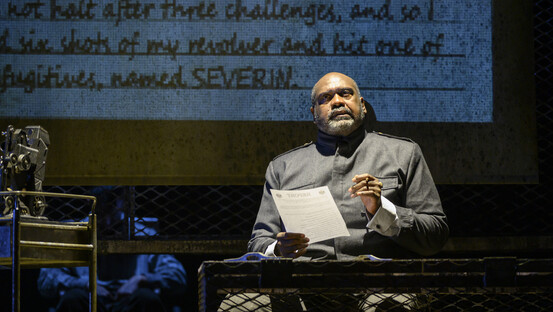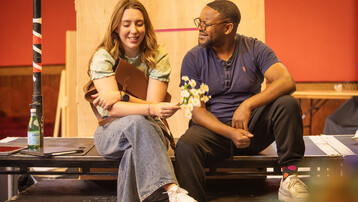News Story
Poulenc’s remarkable song cycle Tel jour telle nuit emerged triumphantly from the ashes of an abandoned work. In December 1936, Poulenc had been working on some settings of Jean Cocteau’s collection of poetry Plain-Chant, but was not happy with them; neither was Pierre Bernac, Poulenc’s regular vocal collaborator, much impressed. Dramatically, Poulenc threw the songs into the fire, writing afterwards: ‘I was happy, relieved, and confident that I still had enough time to compose a new cycle for our February recital because for the past three weeks I had been possessed, working secretly — hiding them even from myself — on a group of new poems by Eluard.’
The poems in this new cycle, premiered by Bernac and Poulenc on 3 February 1937, came from Paul Eluard’s collection Les Yeux fertiles, published in October the previous year. They emerged from a deeply romantic period of Eluard’s life, inspired by his second wife Nusch whom he married in 1934 (his first wife had been Gala, who later married the artist Salvador Dali).
As Sidney Buckland writes, ‘during his years with Nusch, Eluard’s concept of love defines and redefines itself in poems of astonishing beauty. Love, for Eluard, becomes not only a link between two beings but a unifying force, a principle of comprehension and of re-creation of the world…through her, he finds his unity with all things.’ Poulenc’s nuanced, sensitive, and thematically interlinked cycle is a beautiful musical counterpart to these texts.
Eluard and Poulenc had known each other for a number of years by the mid-1930s — a perhaps unlikely pairing. Buckland, in a chapter on their relationship in Francis Poulenc: Music, Art and Literature (1999), draws attention to their differences in terms of outlook and social personality. She shows a photograph of Poulenc in the summer of 1936, dressed as was his custom in a formal, heavy suit, standing next to Bernac, similarly formal and in a self-consciously stiff pose.
The following summer, Eluard was captured at a picnic with Nusch, along with Man Ray and his partner Adrienne and the English Surrealist Roland Penrose — lounging around a low table, the women naked to the waist. The photos represent the artists seemingly from different worlds; yet not only did they find much common ground, but both appreciated what the writer Jean Burgos has termed ‘the coherence of opposites’.
As a Surrealist, the jarring juxtaposition of seemingly contradictory or absurd items was integral to Eluard’s aesthetic approach. Andre Breton, a key figure in the artistic movement, wrote ‘Everything leads one to believe that there exists a certain point of the mind in which life and death, real and imaginary, past and present, communicable and incommunicable, high and low, cease to be perceived contradictorily.’ The poems used in Tel jour telle nuit are full of apparent contradictions which, in the world of the poem, combine to create a powerful and coherent whole, full of energy (such as “Riding full tilt you whose phantom/prances at night on a violin/come and reign in the woods”, from ‘A toutes brides’).
Poulenc’s own inner ‘duality’ — he has famously been referred to as ‘half monk, half guttersnipe’ — can be interpreted not so much as a division but as a demonstration of Guillaume Apollinaire’s dictum that paradoxes are not necessarily opposites. One of Poulenc’s own remarks, sometimes quoted as exemplifying his doubleness, does in fact reinforce his preference for inclusivity. In a letter to Simone Girard, Poulenc writes ‘I have plunged into my Carmelites, and I no longer sleep. Be so good as to send me your recipe for courgette purée.’ Here, then, is a melodramatic ‘plunge’ into artistic endeavour juxtaposed with homely domesticity, but Poulenc is nonetheless articulating two equally pressing concerns. In his music, Poulenc’s ‘two sides’ express themselves in the same way and often at the same time. As Rorem points out, his secular and sacred styles are more or less identical; Poulenc himself instructed an American choir to sing his Gloria ‘like Maurice Chevalier’; and thus Poulenc’s idiom overall is a remarkably elastic thing, capable of being stretched over a wide number of cultural spheres, articulating difference yet simultaneously incorporating difference within the same musical language.
As such, the dramatic language, and embracing spirit of Eluard’s poetry held no challenge for him. He was most comfortable setting the words of his contemporaries, or near contemporaries (such as Cocteau, or the slightly earlier Apollinaire) and created flowing, sensual musical forms from their extraordinary texts. Tel jour telle nuit is perhaps Poulenc’s most purely beautiful cycle, and is musically very much part of a whole. While employing his usual habit of juxtaposing slower settings with briskly rapid ones, there is more structure at play here than in other works. The first two songs are melancholy (yet also ravishing — especially ‘Une ruine coquille vide’, with its melting piano part), then follows the short, rapid ‘Le front’, leading into the drama of ‘Une roulotte’. There are other quick-fire settings, but even within ‘Figure de force’ there is a passage marked lento, and a startlingly intense close. The final song is simply stunning, one of Poulenc’s finest and setting some of Eluard’s most purely romantic words. It concludes with a piano postlude echoing the cycle’s beginning.
Eluard was remarkably generous to Poulenc over the years, quite comfortable allowing for the fact that poetic titles do not always make sense for musical movements, and in fact suggesting the title Tel jour telle nuit himself, rather than the original Les yeux fertiles. He was also somewhat rare in the Surrealist world in appreciating music, which was generally considered something of a secondary art. Poulenc was, of course immeasurably grateful to him, and also to his long-term ‘muse’ Pierre Bernac, as he wrote in his song diary:
People will never know how much I owe to Éluard, how much I owe to Bernac, It is due to them that lyricism has entered my vocal works’.



